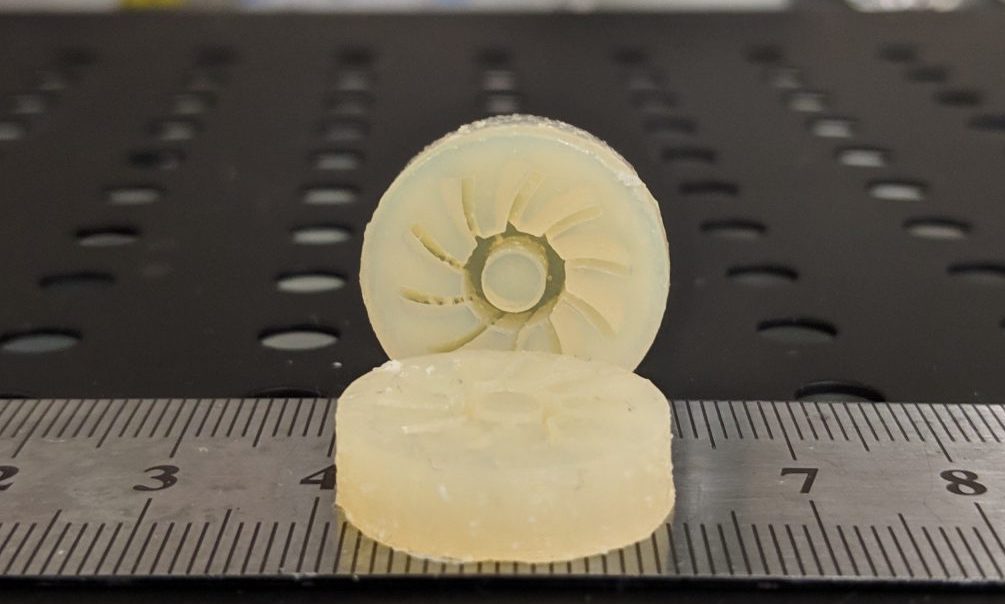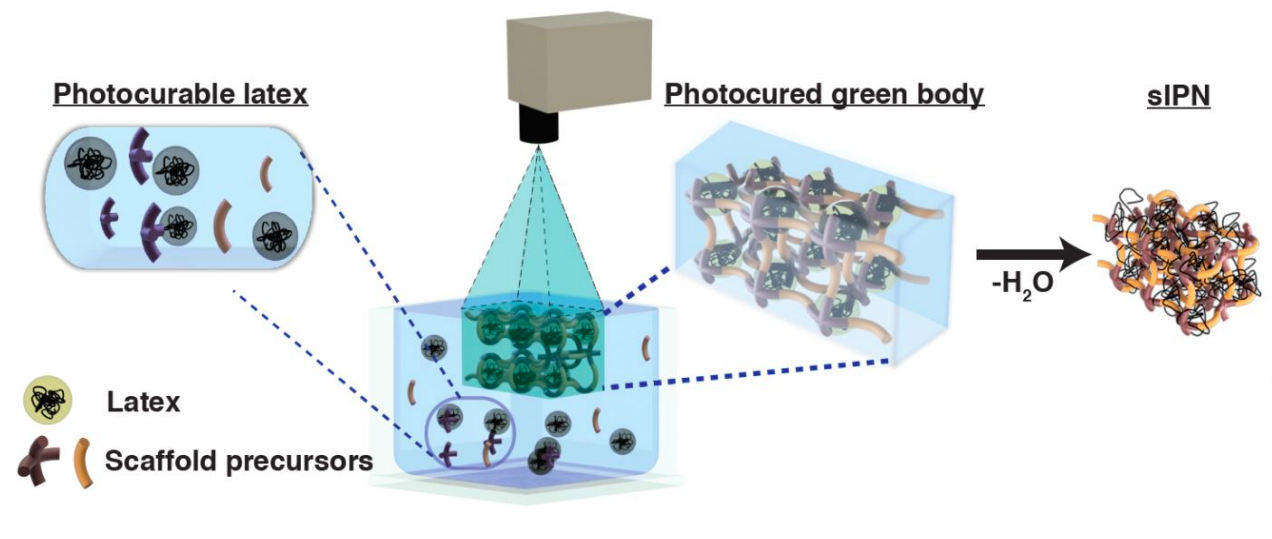An interdisciplinary team of researchers led by Virginia Tech University (VTU’s) Macromolecules Innovation Institute (MII) have collaborated with Michelin North America to create a novel 3D printed latex rubber material.
By adding photoinitiators and other compounds to a latex liquid mixture, the team were able to integrate a supporting scaffold into its polymerization 3D printing process. This new technique yielded a novel latex material exhibiting improved cohesion, which could lead to its future application in areas such as soft robotics, medical devices, and shock absorbers.
“When I was a graduate student working on this technology, we were excited to get unique performance from the shapes we could create, but the underlying assumption was we had to make do with very poor materials,” said Christopher Williams, the L.S. Randolph Professor of mechanical engineering at MII. “What’s been so exciting about this discovery, is being able to push the boundary of what we assumed was the limit of a printed material’s performance.”

Stereolithography 3D printing and latexes
Vat photo-polymerization, also known as stereolithography 3D printing, enables the fabrication of precise and complex geometries, objects printed in this way usually comprise highly crosslinked, polymeric networks. With some materials parts can be brittle. Moreover, because successful photocuring demands that these crosslinks be present to maintain feature fidelity, the resulting parts often feature limited elasticity.
In order for elastomeric objects to be 3D printed for end-use applications, they must be capable of reversibly deforming to high elongations. As of yet, the high molecular weight between crosslink points required to achieve this, has only been accomplished by reducing the amount of crosslinking, hence a different approach was required by the VTU team. Additionally materials produced in existing research, such as that carried out by North Carolina State University in 2017, have suffered from low polymer solubility in the diluent, and high solution viscosity. Thus, fundamental advances in both material and machine were necessary to address this paradox between printability and final performance.
“Latexes are in a state of zen,” explained Viswanath Meenakshisundaram, a fifth-year mechanical engineering Ph.D. student who collaborated on the project. “If you add anything to it, it’ll completely lose its stability and crash out.” To tackle this problem, the VTU team developed a technique which used water-soluble network precursors to create a tunable scaffold, and this surrounded the latex particles, and encouraged their coalescence. The novel method also harnesses the mechanical properties of the dispersed polymer, without disrupting the complex geometric features defined during the 3D printing process.
“When designing the scaffold, the biggest thing you have to worry about is stability of everything,” added Phil Scott, a fifth-year macromolecular science and engineering student in the MII’s Long Research Group. “It took a lot of reading, even stuff as basic as learning why colloids are stable and how colloidal stability works, but it was a really fun challenge.”

The Virginia Tech team’s 3D printing technique
The VTU team’s method begins with adding network precursors and photoinitiator to the latex during its continuous, aqueous phase, in order to enable the photogeneration of the supporting scaffolds. UV exposure during 3D printing then initiates photocrosslinking of these precursors, to form a supporting scaffold around the latex particles, which yields a freestanding “green body” hydrogel.
Subsequent drying and annealing of the green body enables the polymeric particles to diffuse and coalesce throughout the printed object. This results in a semi-interpenetrating polymer network (sIPN), consisting of a photo-crosslinked scaffold network, which serves to design the 3D shape of the object, and an entangled, high molecular weight latex polymer. Meenakshisundaram described the 3D printing process as “like catching a fish in a net.”
“The scaffold gives it a shape. Once you put that in the oven, the water will evaporate, and the tightly coiled polymer chains can relax, spread or flow, and interpenetrate into the net.”
During the 3D printing phase of the process, the VTU team used a custom-made 3D printer to photoinitiate the polymer mix. Nonetheless, even using a tailored system, the fluid latex particles caused scattering outside of the projected UV light on the latex resin surface, which resulted in inaccurate printed parts. In order to get around this, Meenakshisundaram embedded a camera onto the printer to capture an image of each vat of latex resin. With his custom algorithm, the machine was able to ‘see’ the UV light’s interaction on the resin surface, and automatically adjust the printing parameters to correct for the resin scattering.
“Viswanath came up with the idea of embedding a camera, observing how the light interacts with the material, and updating the printing parameters based on his code,” explained Williams, praising the interdisciplinary team’s approach. “That’s what we want from our Ph.D. students: We provide a vision, and they accomplish that and grow beyond as an independent researcher.”

Testing the researchers’ new 3D printed latex materials
For the scaffold to prove functional, it would have to avoid disrupting the latex’s stability, be able to rapidly photocure into a robust network and display good printability, to enable the production of strong end-use parts. In order to test its functionality, the VTU team 3D printed a series of photocurable latex objects. The resulting specimens were produced in high detail, and displayed substantially improved strength over existing latex materials, exhibiting elongations over 500%, with an average stress-at-break of 9.7 MPa.
The team’s new approach also enabled the fabrication of mechanically robust and reusable elastic molds, which could be used for the soft molding of complex geometries that weren’t previously possible using hard molds. As a proof of concept, an impeller was casted in a 3D printed SBR sIPN mold using Field’s metal, and subsequently removed without damaging either component. Dynamic light scattering (DLS) measurements were also taken of the new latex models, and these confirmed that the researchers had indeed produced a stable Styrene-Butadiene Rubber (SBR) elastomer.
“This work expands the opportunities for VP printing of elastomers with intricate features that exhibit extensibilities above 500%, nearly 200% above the leading commercial VP elastomers,” concluded the VTU researchers. “The tunability and modularity of this approach, when combined with diverse scaffold and polymeric particle compositions, suggests versatility beyond SBR latexes and elastomers.”
Elastomer materials in the 3D printing industry
As mentioned, while the combined flexibility and strength provided by elastomer materials makes them desirable, their fragility has often limited their usage. Where they have been introduced, the materials are primarily utilized as resins within Fused Filament Fabrication (FFF) 3D printing applications.
3D Systems for instance, have launched a Figure 4 RUBBER-65A BLK elastomer for 3D printing. The material displays high elongation at break for flexibility and durability, making it well-suited to uses in air/dust gaskets and seals for electronics amongst others.
Similarly, WACKER, the Munich-based chemical group behind the ACEO silicone rubber 3D printing brand, has introduced a new silicone elastomer material. Designed to be utilized within typical silicone applications such as the automotive or aerospace industries, the ACEO elastomers are available with a tensile strength of up to 60 Shore A hardness.
Fillamentum Industrial meanwhile, the performance application brand of Czech 3D printing filament producer Fillamentum, has introduced a selection of materials including a flexible Flexfill TPE elastomer resin. The recyclable, non-toxic material exhibits impact, rebound and chemical resilience, making it suited to use in most commercial FFF 3D printers.
The researchers’ findings are detailed in their paper titled “3D Printing Latex: A Route to Complex Geometries of High Molecular Weight Polymers” published in the Applied Materials and Interfaces journal. The report was co-authored by Philip J. Scott, Viswanath Meenakshisundaram, Maruti Hegde, Christopher R. Kasprzak, Christopher R. Winkler, Keyton D. Feller, Christopher B. Williams, and Timothy E. Long.
You can now nominate for the 2020 3D Printing Industry Awards. Cast your vote to help decide this year’s winners.
To stay up to date with the latest 3D printing news, don’t forget to subscribe to the 3D Printing Industry newsletter or follow us on Twitter or liking our page on Facebook.
Looking for a job in the additive manufacturing industry? Visit 3D Printing Jobs for a selection of roles in the industry.
Featured image shows a 3D model produced using the VTU team’s latex elastomer material. Photo via the Applied Materials and Interfaces journal.



